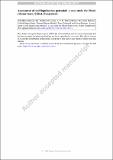| dc.contributor.author | Hossain, Md. S | |
| dc.contributor.author | Kamal, A. S M M | |
| dc.contributor.author | Rahman, Md. Z | |
| dc.contributor.author | Farazi, Atikul H | |
| dc.contributor.author | Mondal, Dhiman R | |
| dc.contributor.author | Mahmud, Tonoy | |
| dc.contributor.author | Ferdous, Nasim | |
| dc.date.accessioned | 2021-09-20T17:17:17Z | |
| dc.date.available | 2021-09-20T17:17:17Z | |
| dc.date.issued | 2020-03-30 | |
| dc.identifier.uri | https://hdl.handle.net/1721.1/131489 | |
| dc.description.abstract | Abstract
Liquefaction can intensify the destruction caused by an earthquake; thus, a region with high liquefaction potential could be more disastrous. Bangladesh is surrounded by the Indo-Burma Folded Belt in the east, the Dauki Fault and Himalayan Syntaxis in the north that are known to have occurred high magnitude earthquakes (e.g., Mw > 7) in the past. Therefore, assessing seismic hazards in the regions that are economically growing fast is of great interest. Among many other hazard assessment parameters, soil liquefaction potential index (LPI) can be used to assess seismic hazards. In this study, we have assessed the seismic hazard potential for a small town (Moulvibazar) in the northeast Bangladesh documenting liquefaction potential indices for different surface geological units using an earthquake of moment magnitude Mw 8 having a peak horizontal ground acceleration (PGA) of 0.36 g. Twenty-five standard penetration test (SPT) boreholes were completed within the study area to obtain SPT-N values for two surface geological units: (1) Holo–Pleistocene low elevated terrace deposits (Zone 1) and (2) Holocene flood plain deposits (Zone 2). Using the SPT-N values, the LPI values have been calculated for the soil profile of each borehole. The LPI values in the town vary from 0 to 42.33, whereas values from 1.42 to 7.52 are in Zone 1 and values from 0 to 42.34 are in Zone 2. It has been predicted that 42% and 78% areas of Zone 1 and Zone 2, respectively, might exhibit surface manifestation of liquefaction. The results of this study can be used for seismic risk management of Moulvibazar town. | en_US |
| dc.publisher | Springer International Publishing | en_US |
| dc.relation.isversionof | https://doi.org/10.1007/s42452-020-2582-x | en_US |
| dc.rights | Article is made available in accordance with the publisher's policy and may be subject to US copyright law. Please refer to the publisher's site for terms of use. | en_US |
| dc.source | Springer International Publishing | en_US |
| dc.title | Assessment of soil liquefaction potential: a case study for Moulvibazar town, Sylhet, Bangladesh | en_US |
| dc.type | Article | en_US |
| dc.identifier.citation | SN Applied Sciences. 2020 Mar 30;2(4):777 | en_US |
| dc.contributor.department | Haystack Observatory | |
| dc.eprint.version | Author's final manuscript | en_US |
| dc.type.uri | http://purl.org/eprint/type/JournalArticle | en_US |
| eprint.status | http://purl.org/eprint/status/PeerReviewed | en_US |
| dc.date.updated | 2020-09-24T21:20:27Z | |
| dc.language.rfc3066 | en | |
| dc.rights.holder | Springer Nature Switzerland AG | |
| dspace.embargo.terms | Y | |
| dspace.date.submission | 2020-09-24T21:20:27Z | |
| mit.license | PUBLISHER_POLICY | |
| mit.metadata.status | Authority Work and Publication Information Needed | |
